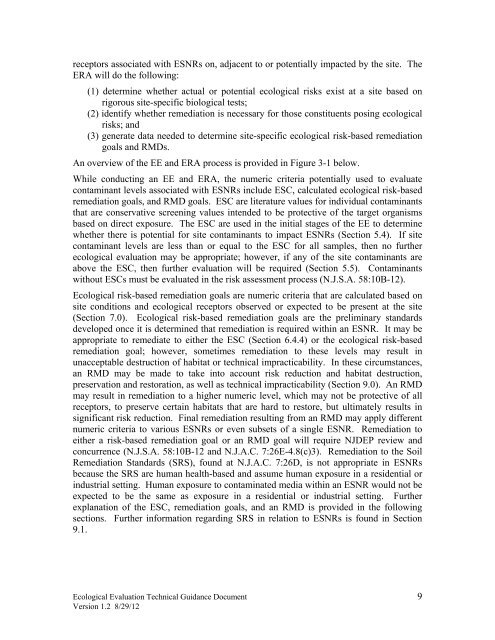Ecological Evaluation Technical Guidance - State of New Jersey
Ecological Evaluation Technical Guidance - State of New Jersey
Ecological Evaluation Technical Guidance - State of New Jersey
- No tags were found...
Create successful ePaper yourself
Turn your PDF publications into a flip-book with our unique Google optimized e-Paper software.
eceptors associated with ESNRs on, adjacent to or potentially impacted by the site. TheERA will do the following:(1) determine whether actual or potential ecological risks exist at a site based onrigorous site-specific biological tests;(2) identify whether remediation is necessary for those constituents posing ecologicalrisks; and(3) generate data needed to determine site-specific ecological risk-based remediationgoals and RMDs.An overview <strong>of</strong> the EE and ERA process is provided in Figure 3-1 below.While conducting an EE and ERA, the numeric criteria potentially used to evaluatecontaminant levels associated with ESNRs include ESC, calculated ecological risk-basedremediation goals, and RMD goals. ESC are literature values for individual contaminantsthat are conservative screening values intended to be protective <strong>of</strong> the target organismsbased on direct exposure. The ESC are used in the initial stages <strong>of</strong> the EE to determinewhether there is potential for site contaminants to impact ESNRs (Section 5.4). If sitecontaminant levels are less than or equal to the ESC for all samples, then no furtherecological evaluation may be appropriate; however, if any <strong>of</strong> the site contaminants areabove the ESC, then further evaluation will be required (Section 5.5). Contaminantswithout ESCs must be evaluated in the risk assessment process (N.J.S.A. 58:10B-12).<strong>Ecological</strong> risk-based remediation goals are numeric criteria that are calculated based onsite conditions and ecological receptors observed or expected to be present at the site(Section 7.0). <strong>Ecological</strong> risk-based remediation goals are the preliminary standardsdeveloped once it is determined that remediation is required within an ESNR. It may beappropriate to remediate to either the ESC (Section 6.4.4) or the ecological risk-basedremediation goal; however, sometimes remediation to these levels may result inunacceptable destruction <strong>of</strong> habitat or technical impracticability. In these circumstances,an RMD may be made to take into account risk reduction and habitat destruction,preservation and restoration, as well as technical impracticability (Section 9.0). An RMDmay result in remediation to a higher numeric level, which may not be protective <strong>of</strong> allreceptors, to preserve certain habitats that are hard to restore, but ultimately results insignificant risk reduction. Final remediation resulting from an RMD may apply differentnumeric criteria to various ESNRs or even subsets <strong>of</strong> a single ESNR. Remediation toeither a risk-based remediation goal or an RMD goal will require NJDEP review andconcurrence (N.J.S.A. 58:10B-12 and N.J.A.C. 7:26E-4.8(c)3). Remediation to the SoilRemediation Standards (SRS), found at N.J.A.C. 7:26D, is not appropriate in ESNRsbecause the SRS are human health-based and assume human exposure in a residential orindustrial setting. Human exposure to contaminated media within an ESNR would not beexpected to be the same as exposure in a residential or industrial setting. Furtherexplanation <strong>of</strong> the ESC, remediation goals, and an RMD is provided in the followingsections. Further information regarding SRS in relation to ESNRs is found in Section9.1.<strong>Ecological</strong> <strong>Evaluation</strong> <strong>Technical</strong> <strong>Guidance</strong> Document 9Version 1.2 8/29/12
















